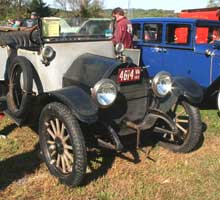Byron Carter was a clever guy. He patented a three-cylinder steam engine, and with two friends he organized the Jackson Automobile Company in Michigan in 1903. By September of that year he had built a two-cylinder runabout for himself using a friction-drive transmission of his own invention.
The concept was extremely simple: two large discs rotating at right angles to one another. One of them was mounted on an axle allowing it to slide in relation to the other. Wherever the discs were allowed to touch resulted in a new gear ratio – Carter called it a “car of a thousand speeds.” To reverse, one simply moved the sliding disc past dead center of the mating disc. Installed in a chassis, the concept became the Cartercar, introduced in 1905.
The Cartercar enjoyed enjoyed a pleasant rise in popularity, sales reaching 325 in 1908. That April, however, Byron Carter died of pneumonia. In October 1909, the Cartercar Company was one of 30 firms bought by Billy Durant and folded into General Motors. Cartercars grew in size and stature – a four-cylinder model replaced earlier singles and twins in 1910. Along the way, Durant was ousted from GM and the modest annual sales of 1,000-2,000 cars failed to impress the directors. Production was halted in 1915 and the Cartercar plant re-purposed to build the Oakland Six. A few other automakers used friction-drive transmissions, among them Lambert, Metz, Petrel, Sears and Simplicity, and the idea was revived later in the 20th Century for lawn mowers.
This 1913 Cartercar appeared in the Historic Preservation of Original Features class at Hershey in 2010. Owner Michael Witt had discovered it barn-fresh, and mechanically resuscitated it to operate as it should, while leaving the patina of body and upholstery alone. Aside from some unobtrusive oxidation it was humbly handsome, and possessed of charming period features like a radiator-neck license plate bracket. The friction mechanism was exposed for all to see, along with the car’s simple controls. Only the tattered top spoiled the mood, and Witt could be excused for disregarding its provenance and replacing it with distressed modern canvas. With better weather protection it would be a thoroughly-practical original “oily rag” car for touring with a thousand speeds.

